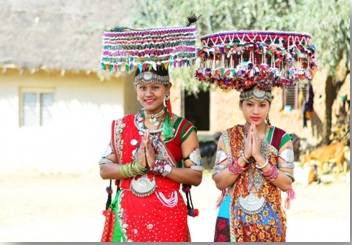

|
Syllabus: Prelims GS Paper I: Economic and Social Development-Sustainable Development, Poverty, Inclusion, Demographics, Social Sector Initiatives, etc. Mains GS Paper I : Salient features of Indian Society, Diversity of India. |
Context: The Uttar Pradesh government is working to popularize Tharu tribe and its culture.
 Background: The Uttar Pradesh government has recently launched a scheme to adopt the unique culture of its ethnic Tharu tribe across the world. The intention is to put Tharu villages on the tourism map, and generate employment and financial independence to the tribal population.
Background: The Uttar Pradesh government has recently launched a scheme to adopt the unique culture of its ethnic Tharu tribe across the world. The intention is to put Tharu villages on the tourism map, and generate employment and financial independence to the tribal population.
In Detail
Uttar Pradesh has a total of five Scheduled Tribes. Out of five STs, Tharu is the most populous tribe, having a population of 83,544. They constitute 77.4% of the total tribal population of the state, according to the 2011 census.
The latest move is aimed at economically strengthening the Tharu tribe by increasing their participation in eco-tourism and reducing their dependency on forest land.
The UP Government aims to popularize tharu culture and make them self economically self dependent, for this the government has set up a complex at a cost of Rs 1.70 crore. It has 10 shops along with four guest rooms, a music room, a restaurant and a museum. Forest corporation will also try to support the tribe members by improving their huts to make them suitable for tourists.
Once tourists start getting familiar with Tharu food, which is healthy and delicious, they would take interest in knowing their culture. When tourists stay in their village to learn about their culture, folk music and medicines, locals will get jobs and be part of tourism activities.
Tharu tribe
The community belongs to the Terai regions among the Shivalikas or the lower Himalayas. Most of them are forest dwellers, and some do agriculture. The word Tharu is believed to have originated from Theravada, meaning followers of Theravada Buddhism.
Thars live in both India and Nepal. In the Indian Terai, they live mostly in Uttarakhand, Uttar Pradesh and Bihar. According to the 2011 census, the Scheduled Tribes population in Uttar Pradesh was more than 11 lakhs; This number is now estimated to have crossed 20 lakhs.
The largest part of this tribal population is made up of Tharus. Members of the tribe survive on wheat, corn and vegetables grown close to their homes. A majority still live far from the forest.
Tharu Culture
They speak various dialects of Tharu, a language of Indo-Aryan subgroup and various forms of Hindi, Urdu and Awadhi. In central Nepal, they speak a version of Bhojpuri, while in eastern Nepal, they speak a version of Maithili.
Tharus worships Lord Shiva as Mahadev, and calls his supreme "Narayana", who believes that he is the provider of sunshine, rain, and crops. Tharu women have more property rights than women in the mainstream North Indian Hindu customs.
Most Tharu tribals consume alcoholic beverages, and some eat beef. Standard items on the Tharu plate are bagiya or dhikri – which is a steamed dish of rice flour that is eaten with chutney or curry – and ghonghi, an edible snail that is cooked in a curry made of coriander, chili, garlic, and onion.
Proposed Scheme
The state government is working to connect Tharu villages in the districts of Balrampur, Bahraich, Lakhimpur and Pilibhit bordering Nepal, with the home stay scheme of the UP Forest Department. The idea is to offer tourists an experience of living in the natural Tharu habitat, in traditional huts made of grass collected mainly from the forests.
The Uttar Pradesh Forest Corporation will train the Tharu people to communicate effectively with visitors, and encourage villagers to acquaint them with aspects of safety and cleanliness, and with the rules of the forest.
Tharu homeowners will be able to charge tourists directly for the accommodation and home-cooked meals. The UP government expects both domestic and international tourists to avail of the opportunity to obtain a taste of the special Tharu culture by staying with them, observing their lifestyle, food habits, and attire.
The homestay scheme will be expanded to include the Tharu villages in a few weeks’ time, according to the government officials.
Conclusion
Most of the tribal community is economically backward, hence to open new avenues of income for the Tharu tribal community is a welcome step. Besides these the government should work on education of the tribal community, as for poor community, sending children into school is a luxury for them. Besides these there is also a requirement of good infrastructure for holistic development of the community.
Connecting the Article
Question for Prelims : Tharu community belongs from
(a) Tamil Nadu
(b) Uttar Pradesh
(c) Kerala
(d) None of the above
Question for Mains : What are the key challenges for economic and social development of tribal community in India ? Discuss government's effort in this regard.

Our support team will be happy to assist you!
